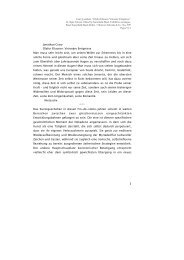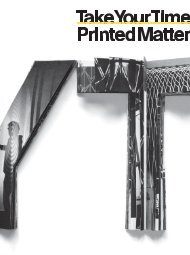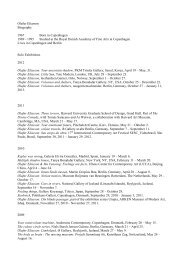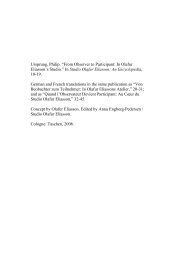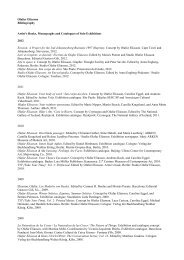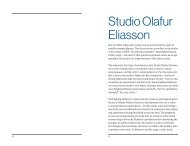VIII — The vessel interview - Olafur Eliasson
VIII — The vessel interview - Olafur Eliasson
VIII — The vessel interview - Olafur Eliasson
Create successful ePaper yourself
Turn your PDF publications into a flip-book with our unique Google optimized e-Paper software.
Obrist, Hans Ulrich. “<strong>VIII</strong> — <strong>The</strong> <strong>vessel</strong> <strong>interview</strong>, part II: NetJets flight from Dubrovnik to Berlin, 2007.”<br />
In <strong>Olafur</strong> <strong>Eliasson</strong> & Hans Ulrich Obrist: <strong>The</strong> Conversation Series; Vol. 13.<br />
Edited by Matthew Gaskins. Cologne: Verlag der Buchhandlung Walter König, Köln, 2008.: 163-178.<br />
<strong>VIII</strong> — <strong>The</strong> <strong>vessel</strong> <strong>interview</strong>, part II<br />
NetJets flight from Dubrovnik to Berlin, 2007<br />
Hans Ulrich Obrist — We’re back on the plane, and this reminds me very much of a previous<br />
<strong>interview</strong> we did on our way back from Eidar. That’s when you looked at the landscape and<br />
made the comment that the way back is always different—a repetition of difference.<br />
<strong>Olafur</strong> <strong>Eliasson</strong> — When we flew back in Iceland, we talked about flying over the route we<br />
had previously traveled in the other direction by car. We flew pretty much exactly over that<br />
route. It’s interesting because when you travel through a landscape, you measure a distance by<br />
referring to it as time. In other words, you say, “That mountain is one hour away.” Or if you’re<br />
hiking, you might say, “This is a four-day hike,” which already gives you a sense of the<br />
distance because the body can normally only do so and so much in four days. And then, when<br />
you start hiking, you begin to use smaller temporal elements, even if you’ve got a map: “That<br />
plateau is four hours away, and the valley is probably twenty minutes from here because it’s<br />
downhill, and then the green area behind it down to the lake is another two hours.” Yesterday<br />
on Lopud Island in Croatia we talked a lot about space-time relationships, institutional<br />
practices, and making a difference. But this difference—nobody actually spoke about what it<br />
is. We all vaguely suggested that it’s related to the inclusion of temporality. So flying with you<br />
now, thinking about Iceland and this idea of distances in landscape being temporal, comes to<br />
mind.<br />
Hans Ulrich Obrist — It’s repetition and difference not only in terms of our journey, but also<br />
in terms of the pavilion, because on Lopud Island we just saw the Venice Pavilion—the<br />
collaboration between you and David Adjaye [Your black horizon, Art Pavilion, Venice<br />
Biennale, 2005]—but in a very different light.<br />
<strong>Olafur</strong> <strong>Eliasson</strong> — That’s true, and now the pavilion has a history. You could tell from the<br />
patina of the wood that it’s grown old. In Lopud, it was already a familiar structure in the way<br />
the light came through the front side; it was all about memory and re-experiencing it, whereas<br />
in Venice, it was more about the expectations of what it would become. This time it had a<br />
different kind of gravity—the gravity of memory. It seemed somehow deeper and more solid<br />
on the ground—perhaps also because it’s going to be there for a few years, whereas at the<br />
Biennale we knew it was transitional. In Croatia it has a lot of different qualities. <strong>The</strong>re’s a<br />
community and cultural history that’s less related to art tourism. Venice has become a<br />
museum. In Croatia, the pavilion seems to suggest a contemporary relationship between the<br />
island and the community—the time we live in rather than an agglomeration of museological<br />
ideas. <strong>The</strong> pavilion, I think, makes the island much more contemporary.<br />
Hans Ulrich Obrist — One of the interesting things about this journey was that it was also a<br />
journey into the past. On the panel this morning you talked a great deal about your beginnings,<br />
and I was intrigued by your remarks about Gestaltpsychologie and the importance it played for<br />
you in art school. When was this exactly?<br />
<strong>Olafur</strong> <strong>Eliasson</strong> — In the late eighties, early nineties. Phenomenology became extremely<br />
important again in the early nineties as it reintroduced, in a sophisticated and complex way, a<br />
relative understanding of object versus subject—that is, of objects in the context of time and<br />
space and what those relationships mean and perform. When I started art school, one thing that<br />
seemed interesting to me about Gestaltpsychologie was that it worked with a specific idea of
the subject—the subject as a very productive entity. This was unlike phenomenology, which<br />
had a much more formal or objective idea of the subject. I think Gestaltpsychologie works<br />
specifically because it also has more to do with cognitive science and neurology. This is what<br />
triggered my interest—the idea that you could reinterpret the meaning of the individual based<br />
on the experience of the artwork.<br />
Hans Ulrich Obrist — And who, in those early days, were your teachers? Who were your<br />
heroes?<br />
<strong>Olafur</strong> <strong>Eliasson</strong> — When I read about Gestaltpsychologie, I focused on the general, basic<br />
experiments—about how expectations could influence the way you see very elementary ideas.<br />
Now I would probably say Maurice Merleau-Ponty and Edmund Husserl, and a little bit later<br />
Gilles Deleuze. But when I work in my studio, things are a bit less philosophical and more<br />
hands-on, and this idea of something more pragmatic or utilitarian is more closely related to<br />
Gestaltpsychologie than it is to phenomenology.<br />
Hans Ulrich Obrist — We’ve never really spoken about art school and who your teachers<br />
were.<br />
<strong>Olafur</strong> <strong>Eliasson</strong> — I forgot to say who my heroes were. I went twice to America to work, in<br />
1990 and 1991, and this was when the art market crashed and everything changed completely.<br />
It was a very odd situation for me, arriving the day after the crash. It was almost entropy. I was<br />
working for an artist called Christian Eckhart. He made monochromes and was one of those<br />
neo-geo-artists, with a slightly more spiritual element to his work—icons and so forth. He<br />
gave me the book about Robert Irwin, Seeing Is Forgetting the Name of the Thing One Sees, 1<br />
which was very inspiring. <strong>The</strong>n I started looking from Robert Irwin to James Turrell to<br />
Gordon Matta-Clark, Larry Bell, and Maria Nordman. So these were my heroes, but I think<br />
they lacked a kind of frictional relationship with the world. In an odd way, they seemed to live<br />
on their own planet. For me, I think Robert Irwin was the best of the group. He’s remained so<br />
true to his principles. But I’ve also become more interested in Michael Asher. <strong>The</strong>re was an<br />
amazing show of his in Switzerland.<br />
Hans Ulrich Obrist — Do you mean the show in the Kunsthalle in Bern where he liberated the<br />
heating radiators [Michael Asher, Kunsthalle Bern, 1992]?<br />
<strong>Olafur</strong> <strong>Eliasson</strong> — Yes, that one. It was a very important show for me. Gordon Matta-Clark,<br />
Robert Smithson—basically where things became more about reality again.<br />
Hans Ulrich Obrist — And what was it about Robert Irwin that interested you?<br />
<strong>Olafur</strong> <strong>Eliasson</strong> — I liked the fact that, in contrast to many of the others, he wasn’t into<br />
mysticism. His work is about pragmatic ideas about the body, space, and experiential issues.<br />
He’s a very generous and spiritual person, but his work isn’t about illusions—it’s about<br />
reality.<br />
Hans Ulrich Obrist — I’m also curious when you began to feel that you were part of an artistic<br />
generation—or at least when you began to feel that there were other people around, who had<br />
similar time-related interests.<br />
<strong>Olafur</strong> <strong>Eliasson</strong> — <strong>The</strong> first time I realized I was part of a generation was when I discovered<br />
that the similarity was not in form but content. <strong>The</strong> nineties were really the time when form<br />
was liberated—everything was post-form and post-matter. And content could to some extent<br />
prescribe the form, because the relationship between form and content changed. Form became<br />
1 Lawrence Weschler, Seeing Is Forgetting the Name of the Thing One Sees: A Life of Contemporary<br />
Artist Robert Irwin (Berkeley, etc.: Univ. of California Press, 1982).
polyphonic and performative; it became nonprescriptive, leaving much to the engagement of<br />
the individual. This is why I also said that phenomenology in the early nineties fell short of<br />
being productive, because it essentially maintained the already existing idea of what a body<br />
and a subject could do in terms of relationships with the surroundings. But as soon as content<br />
was considered a performative element of the work, I started to realize that I had a generation<br />
of people around me. Just think of the work of Carsten Höller, Philippe [Parreno], and<br />
Dominique Gonzalez- Foerster.<br />
Hans Ulrich Obrist — And Rirkrit Tiravanija?<br />
<strong>Olafur</strong> <strong>Eliasson</strong> — Rirkrit is so special, but it’s also about friendships and the artists from the<br />
gallery in Berlin of which I was part—Michel Majerus and the painter Franz Ackermann,<br />
Tobias Rehberger, even Sharon Lockhart and some of the other L.A. artists.<br />
Hans Ulrich Obrist — Felix Gonzalez-Torres once told me that Andrea Rosen’s gallery felt<br />
like home, and I’ve always had the feeling, in terms of your gallery, that there was a very close<br />
relationship. And then there’s your shared studio space with Tacita [Dean] and Thomas<br />
[Demand].<br />
<strong>Olafur</strong> <strong>Eliasson</strong> — It’s important to understand that a good gallery can help an artist make<br />
better art. It’s as simple as that. And this has nothing to do with the market—with the<br />
commodification of objects or with what a gallery fundamentally is, which is a dealer of art.<br />
Because a very good dealer doesn’t just provide the artist with resistance or friction, but gives<br />
him a frame of reference that can be productive. I think the gallery in Berlin—<br />
neugerriemschneider—was extremely productive in this way.<br />
Hans Ulrich Obrist — And what about the shared studio space with Tacita and Thomas?<br />
<strong>Olafur</strong> <strong>Eliasson</strong> — Yes, we all spend a lot of time in the studio—not necessarily all of it<br />
working. So in that sense there’s a bit of a community. And, of course, there are all the other<br />
people working there, as well, which creates a kind of “glue” that turns the whole thing into a<br />
small community. <strong>The</strong>re’s also the fact that my space is located between Thomas and Tacita—<br />
and that I have a large kitchen with a coffee machine. You know how things work when<br />
you’re the one with the coffee machine—it’s where people tend to hang out!<br />
Hans Ulrich Obrist — How is your working relationship with Thomas? Is it osmotic?<br />
<strong>Olafur</strong> <strong>Eliasson</strong> — Thomas, as you can imagine, is very organized and clear about where or<br />
how he draws his line. I’m actually more the type who occupies things. So I’m not sure I<br />
would describe our working relationship as osmotic. In fact, we have different working<br />
methods and, formally, he is very far away from me. <strong>The</strong> closest we ever got to a collaboration<br />
was when Thomas bought a very sophisticated paper-cutting machine, and I instantly sent one<br />
of my people off to learn how to use it so we could profit from Thomas’ investment [laughs].<br />
Hans Ulrich Obrist — You have a lot of people working for you. That’s maybe another aspect<br />
we should talk about. When we first met, you had one assistant, but now your studio is as big<br />
as a mid-sized architecture office, with almost fifty people.<br />
<strong>Olafur</strong> <strong>Eliasson</strong> — Well, at the moment, there are about thirty-five of us.<br />
Hans Ulrich Obrist — Which is the size of Fumihiko Maki’s office. Maki told me once, as<br />
have several other architects, that he never wanted to grow far beyond thirty or forty. If an<br />
office is too big, it doesn’t always produce intelligence, but eliminates it—and creativity. On<br />
the other hand, Jacques Herzog, Zaha Hadid or Rem Koolhaas have hundreds of employees,<br />
and it still seems to work very well. So there are very different rules, very different ways of<br />
inventing an office. But in the art world, there are only a handful of artists with so many
assistants: So I’m very curious how you deal with the complexity of a growing office and how<br />
you ensure that it produces intelligence and doesn’t become something you have to escape.<br />
<strong>Olafur</strong> <strong>Eliasson</strong> — A couple of years ago it really expanded and I went from fifteen people to<br />
twenty-five, thirtyfive, forty-five. At some point, I even had fifty, but now we’re back down to<br />
around thirty-five people. In any case, it’s important to keep in mind that there’s a<br />
fundamental difference between the infrastructure of an architectural office and that of my<br />
studio, where people’s job descriptions vary considerably. For instance, I have two<br />
electricians, two blacksmiths, a carpenter, a furniture builder, as well as geometricians and<br />
artists. I also have two people who are educated in stage design and theater. <strong>The</strong>n, of course, I<br />
have a group of architects, but even within that group there are large differences: some of them<br />
are from the world of graphic design, some do very sophisticated 3D-drawings, and some are<br />
more hands-on. I have an electrical engineer, and I have a light planner. Occasionally, I have<br />
one or two model makers, just as architectural offices do. Finally, the office itself is divided<br />
into rather diverse areas: I have a publication department and an archive with two or three art<br />
historians. And then there’s the bookkeeper and a project manager. But despite the number of<br />
people, it’s still very clear, very hands-on, and it’s also hierarchical to some extent. <strong>The</strong>re’s no<br />
point in suggesting that it’s a kind of a community where everybody is deciding everything<br />
together. It’s clearly organized around a system. This is not to say that I’m always making the<br />
decisions, because I’m not. I do make crucial decisions about what I feel is artistically<br />
important, but there are still hundreds of decisions about bookkeeping, for instance, that I’m<br />
not aware of. Sometimes it eats up my time to talk to everyone, but I don’t have the feeling<br />
that it’s difficult to run. And, at the end of the day, when I look back at what we’ve achieved, I<br />
usually feel that we’ve been very productive.<br />
Hans Ulrich Obrist — It’s also a laboratory of new ideas—a place, for example, where<br />
conferences take place.<br />
<strong>Olafur</strong> <strong>Eliasson</strong> — Yes, it has increasingly taken on a life of its own. Of course, it’s still<br />
guided by the projects we do, and essentially it reflects its surroundings—it’s not an<br />
autonomous body living encapsulated far away from its surroundings. It’s part of the city in<br />
which it is; it’s part of Berlin. <strong>The</strong>re aren’t many areas located today where experiments are<br />
actually taking place, as Molly Nesbit has pointed out. <strong>The</strong>re’s great potential in the fact that<br />
this laboratory has a life that’s partially communicated to the outside, via the experiments that<br />
are brought out, to some extent, in the exhibitions. However, the exhibitions essentially show<br />
the nature of the experiment rather than the experiment itself. So there’s something in the<br />
laboratory that’s rather unique, and this is why it’s almost like a body with its own life—with<br />
its own ideas and mind and production and economy. I’ve increasingly started doing things<br />
such as small symposia and workshops in the studio. I think the next step will be a school—an<br />
art school, if you want to call it that. It will be a school for spatial experiments in close<br />
affiliation with the studio. However, it’s not about education, but about creating language to<br />
communicate. I think people are going to receive an education regardless of whether I found a<br />
school or not, but they’re going to speak different languages, and what I’d like is to create a<br />
stronger affiliation to language. <strong>The</strong>n, hopefully, what one says in the language will also make<br />
sense.<br />
Hans Ulrich Obrist — We spoke about many different types of <strong>vessel</strong>s earlier today—the<br />
gallery as a <strong>vessel</strong>, neugerriemschneider as a <strong>vessel</strong>, your studio with Tacita and Thomas as a<br />
<strong>vessel</strong>. But what about the idea of the museum as a <strong>vessel</strong>? You recently installed an<br />
incredible piece at the Lenbachhaus, which addressed light conditions within museums.<br />
Marcel Broodthaers said the museum is one reality that’s surrounded by many other realities<br />
that are worth being explored. Although we’ve already discussed your major museum shows<br />
with ARC [Musée d’Art moderne de la Ville de Paris] and the Tate, we haven’t talked about<br />
your recent explorations of museums’ more structural aspects. In Munich, it’s an almost<br />
invisible intervention, at least at first glance. It really has more to do with …
<strong>Olafur</strong> <strong>Eliasson</strong> — Temporality.<br />
Hans Ulrich Obrist — Temporality! Maybe we could talk about Munich first, and then about<br />
museums in general.<br />
<strong>Olafur</strong> <strong>Eliasson</strong> — Yes, in the space at the Lenbachhaus in Munich there’s normally daylight<br />
coming through the ceiling. We closed it off, and then I put in a light system that can be<br />
adjusted to emit different qualities of white light. It’s playing with the fact that there’s a<br />
Kandinsky show with some of the paintings that Kandinsky produced on a journey from St.<br />
Petersburg to Tunis, if I’m not mistaken; I think he went via Stockholm, Germany, Italy,<br />
Sicily, and then on to Tunis. So we tried to record the light from the places where he executed<br />
the paintings, and then we took that and put it in the gallery where the paintings are hanging.<br />
It’s not necessarily about the right way to illuminate the paintings—it’s about the fact that<br />
white light is also constructed and not, as we might think, to be taken for granted. It’s about<br />
the fact that our relationship to light is a cultural and geographical matter and not a natural<br />
one. So in this sense, the intervention in the museum is also about showing that art is not<br />
necessarily always or only on the wall, but also placed within an institutional frame that offers<br />
conditions for the experience of looking at the paintings. As Daniel Birnbaum has remarked,<br />
we’ve come to an end with the biennales—with the mega-shows like the documenta. <strong>The</strong><br />
format has collapsed. <strong>The</strong>re isn’t enough content being produced out of these, and we’re all so<br />
saturated in the formal set-up of these places that we don’t read the content anymore. We go<br />
through them in a very unproductive manner and are now in a situation where we need to find<br />
new ways of doing things. And it’s not necessarily the form, but rather the nature of our<br />
relationship to the form of the show that’s not working. A museum is perfectly capable of<br />
reinventing itself without changing its architecture— which brings us back to what I said<br />
about what constitutes the generation I’m part of. It’s not the form or the walls, but the ways<br />
we share an interest in re-inventing reality. This is what the museum in Munich has adapted to.<br />
Hans Ulrich Obrist — <strong>The</strong> Lenbachhaus?<br />
<strong>Olafur</strong> <strong>Eliasson</strong> — Yes, the Lenbachhaus has adapted to this, embarking on a path that<br />
questions whether it’s possible to challenge this very dominant modern idea of the truth—<br />
whether it’s possible to challenge authorship and authenticity, and to do it in the context of<br />
modern masterpieces by Kandinsky, which I think is very daring considering the conservative<br />
nature of most museums today.<br />
Hans Ulrich Obrist — This leads us back to the question of the light we see in museums. It’s<br />
closely related to the white cube. It’s really by convention that, at a certain moment, the<br />
decision was made that the color white should be used. In the panel discussion, you said it<br />
could easily have been a different color—yellow, for example. It’s the same thing with our<br />
<strong>interview</strong> today—we could just as easily have done the <strong>interview</strong> in German or French. It’s<br />
just that the decision was made at a certain moment to proceed in English. White is the color<br />
of museums, and obviously the whole history of modern architecture is related to this color.<br />
Let’s talk about museums and color.<br />
<strong>Olafur</strong> <strong>Eliasson</strong> — White, of course, is not just a color, but a concept—a matter of upbringing<br />
and culture. <strong>The</strong>re’s the idea, for instance, that white has a disinfecting effect on the body. <strong>The</strong><br />
idea of early modern architects was to suddenly purify space by rationalizing the color away,<br />
turning white into this unbelievably dominant idea of liberation. And somehow we now take it<br />
for granted that this is the natural environment for viewing art. This is not all about changing<br />
our desire or changing the color white, but rather realizing that things are often more culturally<br />
constructed than we think.<br />
Hans Ulrich Obrist — My last question, <strong>Olafur</strong>, is one I’ve asked you many times before:<br />
what is your favorite unrealized project?
<strong>Olafur</strong> <strong>Eliasson</strong> — I would like to build a museum—to reevaluate the nature of a museum and<br />
build it from scratch, not renovate an old one. It should be both an art school and a museum,<br />
and in between the two there should perhaps be a little hotel—a place where people come and<br />
spend time.<br />
Hans Ulrich Obrist — A relay?<br />
<strong>Olafur</strong> <strong>Eliasson</strong> — Yes, and maybe the rooms themselves will be the artworks. Maybe the way<br />
people end up spending time in the hotel rooms will be what the students do and the museum<br />
shows. Maybe the life in this building is what, from a museological point of view, will be the<br />
performative element. And the building itself is just the form—it’s a content machine.<br />
Hans Ulrich Obrist — Ah, yes—another <strong>vessel</strong>! This is our <strong>vessel</strong> <strong>interview</strong>, and that should<br />
be part of the title.<br />
<strong>Olafur</strong> <strong>Eliasson</strong> — A <strong>vessel</strong> <strong>interview</strong>—it’s its own vehicle.<br />
Hans Ulrich Obrist — Thank you so much.



